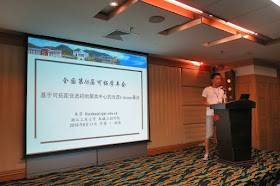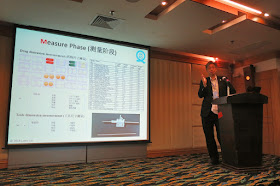The 16th
Annual Meeting of the Extenics (全國第15屆可拓學年會) was organized by Chinese Association for
Artificial Intelligence (CAAI) (中國人工智能學會), undertook by CAAI Extenics Professional
Committee (中國人工智能學會可拓學專業委員會), and Zhuhai Promotion Association of
Science and Technology Innovation (珠海市校企創業創新促進會), Guangzhou Extenics Information
Technology Co., Ltd. (廣州可拓學信息科技有限公司) and 珠海嘉博教育文化有限公司 from 18 to 19 Aug 2018. Minda and I represented HKSQ to join the meeting.
In Day 2
(19 Aug 2018) Morning, it was parallel session.
I joined the second session that I had also shared my study here.
Prof.
Jiang Fan (江帆) (School of Mechanical and Electric Engineering, Guangzhou University)
was the parallel session chair.
The
first speaker was Mr. Zhu Hongyang (朱弘揚) and his presentation entitled “Analysis
and Improvement of Decision Trees with Extension Logic and Extension Thinking
Mode” (可拓邏輯和可拓思維模式對決策樹算法的分析與優化).
Mr. Zhu said Decision Tree algorithm included training and predication. It employed Extenics’ diamond thinking, basic-element divergence and transformation.
The
second speaker was Ms. Wang Nana (王娜娜) and her topic was “Research on
Knowledge Cognition Network Construction and Operation Mechanism Based on
Basic-element Database”(基於基元庫的知識認知網絡建及運行機制研究).
Basic-element Database had four characteristics including Integrity, Relevance, Objective and Environment Adaptation. The whole thinking was showed in the following diagram.
The
third speaker was Mr. Yan Jiameng (嚴家萌) and his topic named “Dynamic Analysis
Method of Node Social Importance Based on Extension Clustering” (基於可拓聚類的複雜社會網絡節點重要性動態分析方法).
Mr. Yan
briefed his research through degree centrality, betweenness Centrality,
Closeness Centrality and K-Shell (KS) index, etc. Finally, he shared their results and
application.
The
fourth speaker was Mr. Chen Jiangdong (陳江棟) and his presentation topic was “Design
of Grinding Equipment based on TRIZ and extenics” (基於TRIZ與可拓學的打磨設備設計).
Mr. Chen
said the innovation method integration between TRIZ and Extenics since 2004 and
he employed it into grinding equipment design.
He concluded to use Extencis theory into TRIZ contradiction table so as
to enhance problem solving efficiency.
The
fifth speaker was Mr. Zhu Fen (朱芬) and his presentation named “Improved k-means Algorithm based on Extension
Distance Selection for Initial Clustering Center” (基於可拓距優選初始聚類中心的改進k-means算法).
Mr. Zhu
said to enhance the accuracy of k-mean for cluster analysis using extension
distance algorithm. Two cases studies
obtained better results than traditional algorithm. Data of Iris improved the accuracy rate from
82.37% to 86.79%; and data of Wine from 60.12% to 65.28%. He concluded that
this method was suitable implementing in Big Data.
Mr. Zhu
Fen (朱芬)
represented his classmate Mr. Xu Chen (徐晨) as the sixth speaker and the
topic named “Research on Extension Conductive Transformation of Product Design”
(產品設計的可拓傳導變換研究).
Mr. Xu study demonstrated the different effect after conductive transformation of design change. However, the establishment of relation network was important in the beginning of study.
The
seventh speaker was Mr. Chen Jian (陳建) and his presentation topic was “E-FSED
model of product green design and conflict resolution” (產品綠色設計的E-FSED模型及衝突消解).
E-FSED model was explained and it included three closures that were Function, Structure and Environment.
The
eighth speaker was Mr. Lu Haoran (盧浩然) and his topic named “Variable Area Table Design
based on TRIZ and Extenics” (基於TRIZ與可拓學的可變面積方桌設計).
Firstly,
Mr. Lu used TRIZ to identify the improvement parameter “Area” and the worse
parameter “Shape”. Using contradiction
table, it identified four inventive principles and selected composition principle
as generic solution. After that he
employed extenics divergence and transformation to the new product design.
Ms. Li
Na (李娜) was the
ninth speaker and her topic entitled “” (可拓突級數法經濟增長綜合評價研究).
Ms. Li study plan was introduced that to analyze economic foundation level (e.g. GDP), economic structure change, economic competitiveness and sustainability level.
I was
the tenth speaker and my topic named “Quality Innovation: Adopts Extenics Six
Sigma (ExSS) Method and Case Study of Automated Process of Elderly Medicine
Packaging” (品質創新: 採用可拓六西格瑪(ExSS)方法和和長者藥板包裝自動化過程案例研). Firstly,
I introduced three common innovative methodology in the world.
Based on
the history of quality and innovation development, this project selected Six
Sigma and Extenics for Quality Innovation study.
Extenics
Six Sigma (ExSS) model was introduced.
Extension Innovation Method combined with DMAIC was found to be suitable
for effective solution generation.
Automated
Process of Elderly Medicine Packaging was employed in this case study and
through extension innovation method to identify the possible solution so as to
enhance the accuracy of the packaging process.
It concluded that DMA-METS-IC was effective and efficiency model.
The eleventh speaker was Mr. Ma Hangtong (馬航通) and his topic entitled “Improvement of Boston Matrix Research Based on Extension Set Method” (基於可拓集方法改進波士頓矩陣研究). Mr. Ma said the limitation of Boston Matrix was mainly suitable for large but not for SMEs.
Mr. Ma added
the product life cycle and also identified contradiction problem in each type
of Boston Matrix and tried to use Extenics to solve it.
The twelfth
speaker was Ms. Han Bo (韓博) and her presentation topic entitled “RBF-based Single- and Dual-weight
Mixture Extension Neural Network” (基於RBF的單雙權混合連接可拓神經網絡). Firstly, she introduced radial basis function
(RBF) neural network.
Then Ms.
Han Bo introduced the establishment of Extension Neural Network (ENN). She enhanced extension distance and worked as
measurement tool. After that Extension
Clustering was employed. The proposed model was showed at the end.
The thirtieth speaker was Mr. Li Wenjun (李文軍) and his topic was “Research on Transformation Methods of Correlation in Extenics” (可拓學中相關關係的變換方法研究).
The Mr.
Li briefed the correlation of Extenics study steps and added “field”
basic-element concept into it.
The
fourteenth speaker was Mr. Zhang Wenlin (張文林) and his topic named “Research
on Improved Functional Analysis based on Basic-element Theory” (基於基元理論的改進功能分析方法研究).
Functional
Analysis was one of TRIZ tools to identify the problem. Mr. Zhang briefed the improvement method
using basic-element to be Integrated Functional Analysis Methodology.
In
another session, Mr. Yin Hanfan (鄞漢藩) (General Secretary, SZIPS) presented “Application
of Extension Conjugate Analysis Method in Patent Resource Analysis” (可拓共軛分析方法在專利資源分析中的運用).
Then Ms.
Lu Bihong (陸碧虹) (SZIPS) presented the topic named “Preliminary Study on Youth
Education Model of Extension Innovation Method” (可拓創新方法青少年教育模式初探).
After
the morning session, we had lunch together.
Minda took a photo with Ms. Li Jianming (李劍明) and Ms. Lu Bihong (陸碧虹).
In
afternoon, Prof. Cai Wen (蔡文) gave keynote speech named “Internationalization, Socialization and Technicalization
of Extenics” (可拓學的國際化、社會化和技術化). First,
he reviewed the past 40 year’s development.
Incubation period was started from 1976 to 1983. The first article named
“Extension Set and Incompatible Problem” which issued in 1983 indicating the
new Chinese Original Discipline birth.
Prof.
Cai Wen thanked many people who supported Extenics in the past. It included
famous person in Hong Kong – Dr. Henry Fok (霍英東).
After
that Prof. Cai briefed the Extension Thinking and Four Steps of Extension
Innovation Method. For
internationalization, international scholars were invited to study in the
institute for Extenics and many conferences and seminars were also
arranged. For Socialization, Extenics’
trainings were entered into industry and school.
For Technicalization,
Prof. Cai introduced that Extenics was one of AI basic theory. The video recorded his explanation
below.
Panel
discussion, Ms. Liu Hui (劉惠) (珠海市校企創業創新促進會副會長兼秘書長) chaired this session. Extenics experts included Prof. Liu Wei (劉巍) (Dalian Maritime University - 大連海事大學), Prof. Yang Chunyan (楊春燕), Prof. Xingsen Li (李興森) and Prof. Zhao Yanwei (趙燕偉) (Zhejiang University of
Technology).
Prof.
Yang Chunyan (楊春燕) discussed what is Extension Intelligence (Extenics + AI), Why we need
it? And what is industry need? She said
Extenics aimed to enhance human intelligence and machine intelligence to solve
contradiction problem.
Prof.
Xingsen Li (李興森) said we were in the fast change era and industry staff needed
innovation capability to face this era.
Therefore, industry training for extenics was important such as solving
technical problem under in-house training.
Prof.
Zhao Yanwei (趙燕偉) said “Made in China 2025” was smart manufacturing. Extension Design was important because of
Design in the early stage and then to manufacturing and to Market. Extension Intelligence needed to implement in
smart manufacturing.
Prof.
Liu Wei (劉巍) said the core of Sino-US competition was innovation capability. He also mentioned The Innovation &
Entrepreneurship Education Alliance of China (中國高校創業創新聯盟) and enhancing industry
innovation thinking.
After
that the award presentation session was performed, Prof. Yang Chunyan (楊春燕) presented certificate to
awardees.
I was
honor to be one of outstanding contributors in the committee (優秀工作者).
Then Prof.
Zhao Yanwei (趙燕偉) presented the Outstanding Contribution on Promoting Extenics
Innovation Method Award to participants.
After
that Prof. Cai Wen (蔡文) presented the Outstanding Contribution on Promoting Extenics
Innovation Method Award for organization (可拓創新方法應用推廣先進單位).
HKSQ was honor to be one of awardees.
At the
end, Prof. Yang Chunyan (楊春燕) gave a closing speech. She
expected extenics and innovation would have great development in Zhuhai.
Before
dinner, we took some photos for memory.
Photo
with Ms. Lu Bihong (陸碧虹), Mr. Yin Hanfan (鄞漢藩) and Prof. Zhao Yanwei (趙燕偉)
Minda
and I took a photo with Ms. Guo Jiayong (郭嘉詠) (GM, Zhuhai M&G Education
Science and Technology Co., Ltd.)
Ms. Liu
Hui (劉惠) (珠海市校企創業創新促進會副會長兼秘書長) appreciated all participants
and started the dinner.
Mind and
I left early back to Hong Kong.
Reference:
Research
Institute of Extenics and Innovation Methods, GDUT (廣東工業大學可拓學與創新方法研究所) - http://extenics.gdut.edu.cn/info/1041/1302.htm
Previous Extenics Annual
Meeting activities:
20160810:
Pre-Extenics Annual Meeting (全國第15屆可拓學年會) – Extenics Level 1 Exam - https://qualityalchemist.blogspot.com/2016/08/pre-extenics-annual-meeting-15-extenics.html
20160811:
The 15th Annual Meeting of the Extenics (全國第15屆可拓學年會) – Day 1 - https://qualityalchemist.blogspot.com/2016/08/the-15th-annual-meeting-of-extenics-15.html
20160812:
The 15th Annual Meeting of the Extenics (全國第15屆可拓學年會) – Day 2 - https://qualityalchemist.blogspot.com/2016/08/the-15th-annual-meeting-of-extenics-15_12.html


















































沒有留言:
發佈留言